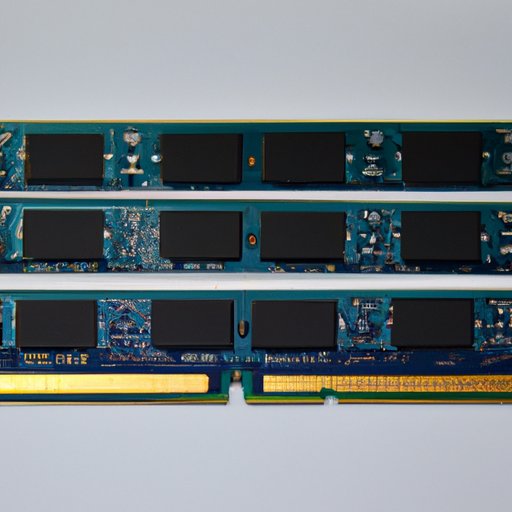I. Introduction
Random Access Memory (RAM) is a key component in the overall performance of a computer. RAM is responsible for managing the computer’s active processes, actively retrieving, and storing data for the CPU to use quickly. Insufficient RAM can lead to poor computer performance, slow processing speeds, and frequent crashes.
Knowing how much RAM your computer has is important. However, it may not be immediately obvious how to determine how much RAM you have installed. This guide will walk you through step-by-step instructions for using simple methods to check your computer’s RAM capacity on both Windows 10 or Mac operating systems. We will also explain third-party software options available for viewing system specifications.
II. Simple Methods to Check Your Computer’s RAM in Windows 10
Checking your computer’s RAM on Windows 10 is straightforward. Here is a simple step-by-step guide to check your RAM:
- Open the Start menu by clicking on the Windows icon in the lower-left corner of your screen. Type “system information” in the search bar and select the System Information app.
- Once the System Information app has opened, under “System Summary” on the left-hand side, look for “Installed Physical Memory (RAM)” to check how much total RAM you have.
- Next, look for “Available Physical Memory” to see how much RAM is currently available to use.
- To see how much RAM each application is using, select “Software Environment” in the left-hand menu and select “Running Tasks.” RAM usage will be displayed under the “Memory” tab.
III. 5 Quick Steps to Check Your Mac’s Memory Usage
To check your Mac’s memory usage, you can utilize the built-in Activity Monitor application. Here are five quick steps to check your Mac’s memory usage:
- Open the Applications folder and locate the Utilities folder. Within the Utilities folder, open the Activity Monitor application.
- Once you have the Activity Monitor application open, select the “Memory” tab to view your Mac’s current memory usage.
- The Activity Monitor app provides a detailed display of memory usage, including total memory, memory used, memory free, and cached files.
- Alternatively, you can use the Terminal application to check your Mac’s memory usage by entering the command: “top -o memory.”
- After entering the command in Terminal, the app will display memory usage sorted by which applications are using the most RAM.
IV. Using Third-Party Software to Determine Installed RAM
If you prefer, you can also use third-party software to get more detailed information about your computer’s RAM. Here are two popular options:
A. CPU-Z
CPU-Z is a free utility software available for Windows. The program does not require installation and is portable, meaning you can run it directly from a USB drive. To use CPU-Z to check your computer’s RAM capacity:
- Download and extract the latest version of CPU-Z.
- Open the CPU-Z executable file and select the “Memory” tab to view your installed RAM capacity.
B. Speccy
Speccy is another free system information utility software available for Windows. To use Speccy to check your computer’s RAM capacity:
- Download and install the latest version of Speccy.
- After installation, open Speccy and under the “Memory” section, you can view your installed RAM capacity and specifications.
V. Why It’s Important to Check Your Computer’s RAM Capacity
Insufficient RAM can impact your computer’s performance in significant ways. If you are experiencing issues like slow application startup or your computer freezing, it’s likely an issue with your computer’s RAM capacity. Checking your computer’s RAM regularly can prevent these problems from impacting your daily tasks.
It’s especially important to monitor your RAM if you plan on upgrading your hardware as well. Knowing your RAM capacity can ensure that you purchase the appropriate RAM for your computer and that your new hardware upgrades will run seamlessly with your existing computer parts.
VI. A Beginner’s Guide to Understanding RAM
To fully understand computer performance, it’s essential to have basic knowledge about the role of RAM. RAM is responsible for holding the data that your computer is currently working on, which includes currently running applications or programs. When the CPU needs to execute a set of instructions, it retrieves the data from RAM and stores the processed data back into RAM. This process creates a temporary workspace, allowing your computer to retrieve the data more quickly and more efficiently than it would from slower storage drives.
As mentioned before, checking your RAM capacity is easy. For Windows 10 and Mac operating systems, use the methods detailed earlier in this article to view how much RAM you have installed.
VII. Conclusion
Checking your computer’s RAM capacity regularly can help you avoid potential performance issues and ensure that you are getting the most out of your computer. Whether you are using Windows 10 or Mac, the methods we covered in this article are simple to follow and don’t require any additional software. However, if needed, there is also third-party software for identifying your RAM’s capacity and other crucial system specifications. By being mindful of your computer’s RAM capacity and understanding how it works, you can ensure optimal performance and use of your hardware.
